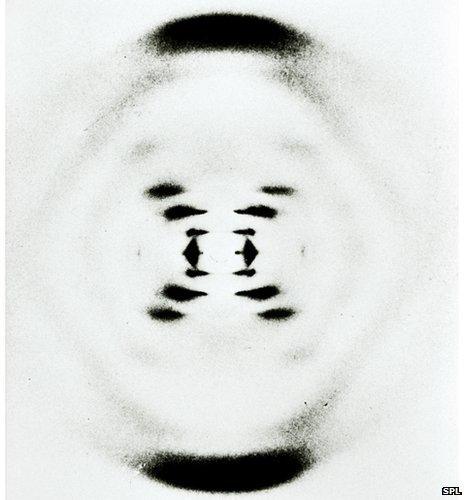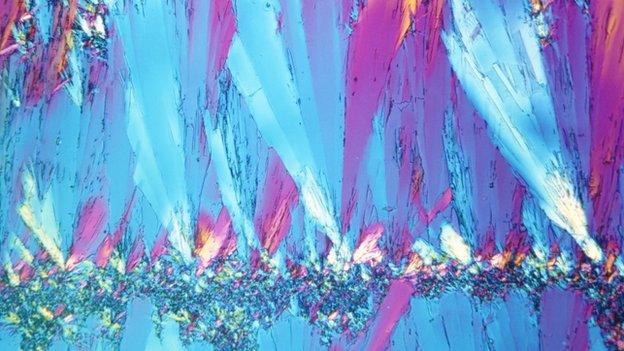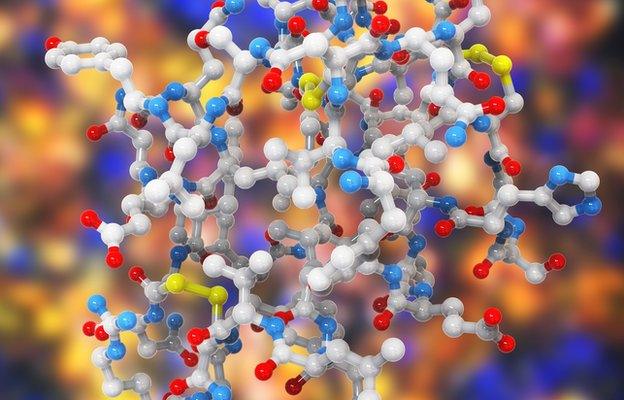Unsung technique behind key science discoveries
- Published

Crystallography is a vital scientific method for understanding the properties of solid objects. It underpins many fields of study, yet remains relatively unknown. Scientists are celebrating a century of the technique being used and are hoping to raise its profile.
X-ray crystallography is a variation of the method that is used to determine the structure of crystalline solids. The unique shadows - or dots - reveal how the arrangement of atoms within the crystal fit together to form the object.
In the words of Nobel laureate Max Perutz it shows "why blood is red and grass is green, why diamond is hard and wax is soft, why graphite writes on paper and silk is strong".
The history
When Rosalind Franklin and Maurice Wilkins experimented with X-ray crystallography, the iconic photo 51 was born. It was this pattern of dots that enabled Francis Crick and James Watson to reveal the beautiful double helix structure of DNA.
But the story of crystallography starts much earlier.

A pattern of dots revealed DNA's double helix structure
German physicist Max von Laue was an early pioneer, earning a Nobel prize for his experiments in 1914. Then the father and son duo William and Laurence Bragg stepped in.
The Braggs are regarded as founders of X-ray crystallography; they analysed the way crystals scatter, or diffract, into patterns on photographic plates.
It is these patterns that can be used to tease out the three-dimensional structures of an object under study.

Dorothy Hodgkin is remembered as one of the main founders of protein crystallography
The International Union of Crystallography counts 48 Nobel Prizes, external which can in some way be attributed to the field of crystallography.
Dorothy Hodgkin used the technique to discover not only the structure of penicillin but also that of Vitamin B12, and later insulin, a larger molecule than anyone had previously attempted. She was awarded the 1964 prize in chemistry for her efforts.
Other structures such as myoglobin and haemoglobin were also later recognised with Nobel Prizes.
"It cannot be overstated just how important the subject is," says Mike Glazer, emeritus professor of physics at the University of Oxford.
"If it were not for the discovery made 100 years ago, the world would look a very different place than it does now," he adds.
"You're surrounded by solid materials, most of those materials you see are crystalline.
What the Braggs and von Laue did enabled us to understand the atomic arrangement in all those solids. That's very important if you want to make new materials or if you want to understand how materials work, Prof Glazer told the BBC's Inside Science programme.
'A bit of a mystery'

Crystallography underpins many fields yet scientists say it rarely gains attention in its own right.
"Since the beginning of time, people have been fascinated by the beauty, purity, mystery and properties of crystals," says Peter Strickland of the International Union of Crystallography.
Despite this, the field is often hidden behind more mainstream scientific areas.
Prof Glazer says: "Although other subjects make use of what we do, it's true to say that many of my fellow scientists find crystallography a bit of a mystery."
This is because complex maths is involved in further determining the structure of objects, he says.
"What we get is spots on a film and we have to work back to the structure without necessarily having a model. That requires you to measure the intensity of the spots very precisely and do a lot of fairly complicated mathematics to reform an image of the object that gave rise to the diffraction pattern," Prof Glazer says.
"It's had an enormous impact yet at the same time there's so little known about it in the public domain," he adds.
Future benefits

Knowing the atomic arrangement of penicillin helped scientists synthesize it
Crystallography offers scientists a useful insight into the structure of proteins and, from there, they can develop experiments which could help drug discoveries.
It is a great example of the universality of science, says Mr Strickland.
"Modern drug development and nano and biotechnology are all based on crystallographic results. The properties of solid forms of active pharmaceutical ingredients depend heavily on their internal structure.
"Crystallographic experiments underpin the development of practically all new materials, from everyday ones like toothpaste, chocolate and computer memory, to advanced car and aerospace components."
"A century has passed since crystals first yielded their secrets to X-rays," adds Mr Strickland. To this day, they allow scientists to design powerful new materials and drugs.

Dorothy Hodgkin used X-rays to elucidate the structure of insulin
Inside Science is broadcast on BBC Radio 4 on Thursdays at 16:30 and 21:00. Listen to the full Inside Science programme here or download the podcast here.
- Published16 July 2013
- Published17 February 2013